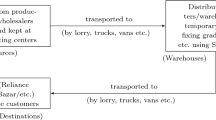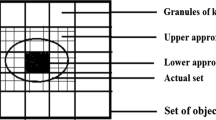Abstract
In this paper, a multi-objective model for two-stage fixed charge transportation planning problem is studied. The transportation process is considered to occur from manufacturing plants to the distributers and then from distributers to the customers. The availabilities at the manufacturing plants, capacities of the distributers and demand of the customers, all are considered to be fuzzy numbers. The proposed model is formulated with three conflicting goals or objective functions. The first objective is to minimize the total transportation cost involved in the whole transportation process. The second objective is to maximize the total quantity of the products to be transported, whereas minimizing the total deterioration that occurred during the transportation process is considered to be the third objective function. Fuzzy linguistic relations or preferences among the three objective functions are studied. A linear membership function is used to represent the fuzzy relative preferences between the objective functions. For solving the multi-objective problem, fuzzy goal programming technique is adopted with some linear and nonlinear membership functions. Finally, the proposed model is illustrated and solved for some simulated numerical data and some sensitivity analysis for the problem is also discussed. The best results for the solved numerical problem are found when hyperbolic membership functions are considered to model the aspiration levels for objective functions, whereas comparatively less significant results are found when linear membership functions are used to model the aspiration levels for objective functions.






Similar content being viewed by others
References
Abualigah LM, Khader AT (2017) Unsupervised text feature selection technique based on hybrid particle swarm optimization algorithm with genetic operators for the text clustering. J Supercomput 73(11):4773–4795
Abualigah LM, Khader AT, Al-Betar MA, Alomari OA (2017a) Text feature selection with a robust weight scheme and dynamic dimension reduction to text document clustering. Expert Syst Appl 84:24–36
Abualigah LM, Khader AT, Al-Betar MA, Hanandeh ES (2017b) A new hybridization strategy for krill herd algorithm and harmony search algorithm applied to improve the data clustering. Management 9(11)
Abualigah LM, Khader AT, Hanandeh ES, Gandomi AH (2017c) A novel hybridization strategy for krill herd algorithm applied to clustering techniques. Appl Soft Comput 60:423–435
Abualigah LM, Khader AT, Hanandeh ES (2018a) A combination of objective functions and hybrid Krill herd algorithm for text document clustering analysis. Eng Appl Artif Intell 73:111–125
Abualigah LM, Khader AT, Hanandeh ES (2018b) Hybrid clustering analysis using improved krill herd algorithm. Appl Intell 48:1–25
Abualigah LM, Khader AT, Hanandeh ES (2018c) A new feature selection method to improve the document clustering using particle swarm optimization algorithm. J Comput Sci 25:456–466
Aköz O, Petrovic D (2007) A fuzzy goal programming method with imprecise goal hierarchy. Eur J Oper Res 181(3):1427–1433
Arqub OA (2017) Adaptation of reproducing kernel algorithm for solving fuzzy Fredholm–Volterra integrodifferential equations. Neural Comput Appl 28(7):1591–1610
Arqub OA, Mohammed AS, Momani S, Hayat T (2016) Numerical solutions of fuzzy differential equations using reproducing kernel Hilbert space method. Soft Comput 20(8):3283–3302
Arqub OA, Al-Smadi M, Momani S, Hayat T (2017) Application of reproducing kernel algorithm for solving second-order, two-point fuzzy boundary value problems. Soft Comput 21(23):7191–7206
Balakrishnan H, Padmanabhan VN, Seshan S, Katz RH (1997) A comparison of mechanisms for improving TCP performance over wireless links. IEEE/ACM Trans Netw 5(6):756–769
Díaz-Madroñero M, Mula J, Jiménez M (2014a) A modified approach based on ranking fuzzy numbers for fuzzy integer programming with equality constraints. In: Prado-Prado J, García-Arca J (eds) Annals of industrial engineering 2012. Springer, London, pp 225–233
Díaz-Madroñero M, Mula J, Jiménez M (2014b) Fuzzy goal programming for material requirements planning under uncertainty and integrity conditions. Int J Prod Res 52(23):6971–6988
Gen M, Li Y (1999) Spanning tree-based genetic algorithm for the bicriteria fixed charge transportation problem. In: Proceedings of the 1999 congress on evolutionary computation, 1999. CEC 99, vol 3. IEEE, pp 2265–2271
Geoffrion AM, Graves GW (1974) Multicommodity distribution system design by Benders decomposition. Manage Sci 20(5):822–844
Ghiani G, Laporte G, Musmanno R (2004) Introduction to logistics systems planning and control. Wiley, New York
Giri PK, Maiti MK, Maiti M (2014) Fuzzy stochastic solid transportation problem using fuzzy goal programming approach. Comput Ind Eng 72:160–168
Guisewite GM, Pardalos PM (1990) Minimum concave-cost network flow problems: applications, complexity, and algorithms. Ann Oper Res 25(1):75–99
Hajiaghaei-Keshteli M, Yousefi K, Afshari AJ (2018) Solving the fixed charge transportation problem by new heuristic approach. J Optim Ind Eng 12(1):41–52. https://doi.org/10.22094/joie.2017.738.1469
Heilpern S (1992) The expected value of a fuzzy number. Fuzzy Sets Syst 47:81–86
Hirsch WM, Dantzig GB (1968) The fixed charge problem. Nav Res Logistics Q 15(3):413–424
Hitchcock FL (1941) The distribution of a product from several sources to numerous localities. Stud Appl Math 20(1–4):224–230
Jawahar N, Balaji AN (2009) A genetic algorithm for the two-stage supply chain distribution problem associated with a fixed charge. Eur J Oper Res 194(2):496–537
Jiménez M (1996) Ranking fuzzy numbers through the comparison of its expected intervals. Int J Uncertain Fuzziness Knowl Based Syst 4(04):379–388
Jiménez M, Arenas M, Bilbao A, Rodrı MV (2007) Linear programming with fuzzy parameters: an interactive method resolution. Eur J Oper Res 177(3):1599–1609
Kundu P, Kar S, Maiti M (2014) Fixed charge transportation problem with type-2 fuzzy variables. Inf Sci 255:170–186
Majumder S, Kundu P, Kar S, Pal T (2018) Uncertain multi-objective multi-item fixed charge solid transportation problem with budget constraint. Soft Comput 1–23. https://doi.org/10.1007/s00500-017-2987-7
Molla-Alizadeh-Zavardehi S, Hajiaghaei-Keshteli M, Tavakkoli-Moghaddam R (2011) Solving a capacitated fixed-charge transportation problem by artificial immune and genetic algorithms with a Prüfer number representation. Expert Syst Appl 38(8):10462–10474
Murty KG (1968) Solving the fixed charge problem by ranking the extreme points. Oper Res 16(2):268–279
Nemhauser GL, Wolsey LA (1988) Integer and combinatorial optimization. Interscience series in discrete mathematics and optimization. Wiley, New York
Ojha A, Das B, Mondal S, Maiti M (2010) A solid transportation problem for an item with fixed charge, vechicle cost and price discounted varying charge using genetic algorithm. Appl Soft Comput 10(1):100–110
Pramanik S, Jana DK, Mondal SK, Maiti M (2015) A fixed-charge transportation problem in two-stage supply chain network in Gaussian type-2 fuzzy environments. Inf Sci 325:190–214
Sadeghi-Moghaddam S, Hajiaghaei-Keshteli M, Mahmoodjanloo M (2017) New approaches in metaheuristics to solve the fixed charge transportation problem in a fuzzy environment. Neural Comput Appl 1–21. https://doi.org/10.1007/s00521-017-3027-3
Sun M, Aronson JE, McKeown PG, Drinka D (1998) A tabu search heuristic procedure for the fixed charge transportation problem. Eur J Oper Res 106(2–3):441–456
Yang L, Feng Y (2007) A bicriteria solid transportation problem with fixed charge under stochastic environment. Appl Math Model 31(12):2668–2683
Yang L, Liu L (2007) Fuzzy fixed charge solid transportation problem and algorithm. Appl Soft Comput 7(3):879–889
Zadeh L (1963) Optimality and non-scalar-valued performance criteria. IEEE Trans Autom Control 8(1):59–60
Zhang B, Peng J, Li S, Chen L (2016) Fixed charge solid transportation problem in uncertain environment and its algorithm. Comput Ind Eng 102:186–197
Zimmermann HJ (1978) Fuzzy programming and linear programming with several objective functions. Fuzzy Sets Syst 1(1):45–55
Author information
Authors and Affiliations
Corresponding author
Ethics declarations
Conflict of interest
All the Authors declare that they have no conflict of interest.
Ethical approval
This article does not contain any studies with human participants or animals performed by any of the authors.
Additional information
Communicated by V. Loia.
Publisher’s Note
Springer Nature remains neutral with regard to jurisdictional claims in published maps and institutional affiliations.
Rights and permissions
About this article
Cite this article
Hashmi, N., Jalil, S.A. & Javaid, S. A model for two-stage fixed charge transportation problem with multiple objectives and fuzzy linguistic preferences. Soft Comput 23, 12401–12415 (2019). https://doi.org/10.1007/s00500-019-03782-1
Published:
Issue Date:
DOI: https://doi.org/10.1007/s00500-019-03782-1




